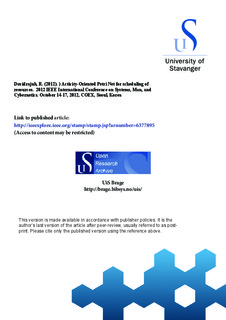| dc.contributor.author | Davidrajuh, Reggie | |
| dc.date.accessioned | 2017-02-22T09:58:31Z | |
| dc.date.available | 2017-02-22T09:58:31Z | |
| dc.date.issued | 2012-10 | |
| dc.identifier.citation | Davidrajuh, R. (2012) Activity-Oriented Petri Net for scheduling of resources. 2012 IEEE International Conference on Systems, Man, and Cybernetics. October 14-17, 2012, COEX, Seoul, Korea | |
| dc.identifier.uri | http://hdl.handle.net/11250/2431689 | |
| dc.description.abstract | This work presents a new methodology for modeling discrete systems in which activities compete for resources. The new methodology known as Activity-Oriented Petri Net (AOPN) allows modelers to concentrate on modeling activities, and the resources are assumed to be managed by the underlying system; this approach allows compact and much simpler models even for large and complex systems. General Purpose Petri Net Simulator (GPenSIM) is a realization of AOPN methodology on MATLAB platform. In addition to comparison of AOPN methodology with the other existing methodologies, a case study is also provided in this paper to better explain how an AOPN model of a resource scheduling problem can be modeled and simulated with GPenSIM. | nb_NO |
| dc.language.iso | eng | nb_NO |
| dc.publisher | IEEE | nb_NO |
| dc.subject | MATLAB | nb_NO |
| dc.subject | resource management | nb_NO |
| dc.subject | roboter | nb_NO |
| dc.subject | computational modeling | nb_NO |
| dc.subject | GPenSIM | nb_NO |
| dc.subject | activity-oriented Petri net | nb_NO |
| dc.subject | resource sharing | nb_NO |
| dc.subject | discrete event dynamic systems | nb_NO |
| dc.subject | discrete event systems | |
| dc.title | Activity-Oriented Petri Net for scheduling of resources | nb_NO |
| dc.type | Conference object | nb_NO |
| dc.rights.holder | © 2012 IEEE. Personal use of this material is permitted. Permission from IEEE must be obtained for all other uses, in any current or future media, including reprinting/republishing this material for advertising or promotional purposes, creating new collective works, for resale or redistribution to servers or lists, or reuse of any copyrighted component of this work in other works | nb_NO |
| dc.subject.nsi | VDP::Teknologi: 500::Informasjons- og kommunikasjonsteknologi: 550::Teknisk kybernetikk: 553 | nb_NO |
| dc.source.journal | IEEE International Conference on Systems, Man, and Cybernetics | nb_NO |
| dc.identifier.doi | 10.1109/ICSMC.2012.6377895 | |
